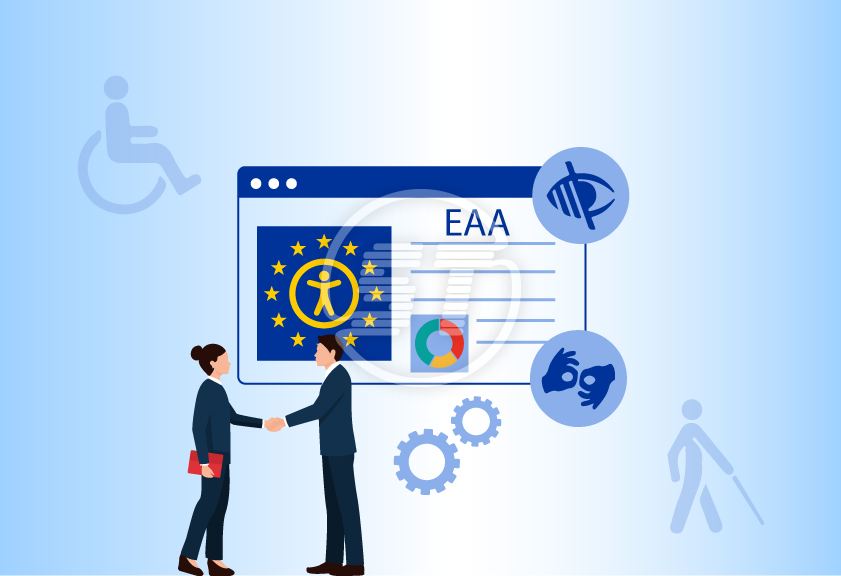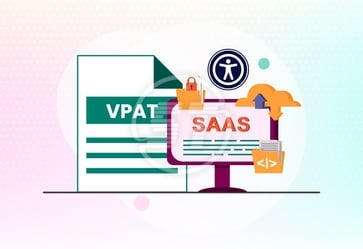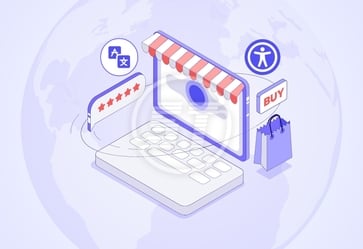From June 28, 2025, The European Accessibility Act (EAA) has been enforced on all consumer-facing businesses. And when we are talking about consumer-facing, isn’t B2B (business-to-business) also part of this? Because even B2B interaction involve some consumers that may suffer any of the physical or cognitive disability.
So, if an organization is bewildered about EAA conformance; the answer is: Yes, in many cases – especially if they are part of a digital supply chain, provide ICT services, or serve public entities – B2B ought to comply with EAA.
Accessibility is no longer just a corporate social responsibility buzzword – it’s an imperative to register success and growth in numbers. And how B2B can left untouched with this wave of digital accessibility.
Let’s break down what the European Accessibility Act means for B2B companies and why compliance is not just a legal checkbox, but a strategic advantage.
What is the European Accessibility Act?
The European Accessibility Act (Directive (EU) 2019/882) is a landmark piece of legislation aimed at improving accessibility for persons with disabilities across the European Union. It covers a wide range of digital and physical products and services, including:
- Ecommerce websites and mobile apps.
- Banking services and ATMs.
- Ticketing and check-in machines.
- Smartphones and computers.
- E-books and e-readers
- Telecommunication services
The Act mandates that these offerings be accessible to all, aligning with the principles of the UN Convention on the Rights of Persons with Disabilities (CRPD).
Do B2B organizations fall under the EAA?
Yes – directly and indirectly.
While the Act’s primary focus is on consumer-facing products and services, many B2B companies are affected in the following ways:
- Supplying to B2C clients
If a B2B company supplies components, software, or services that are used in consumer products covered by the EAA, then those components must support accessibility. Non-compliance could lead to losing contracts with EAA-regulated clients.
- Digital products and services
If a B2B company sells enterprise software, cloud services, hardware, or digital tools, those may fall under the Act if they’re used in public procurement or mass-market applications.
- Public sector and cross-border services
If an organization sells to public institutions in the EU or provides services across EU borders, EAA compliance becomes essential – non-compliance can result in disqualification from tenders and partnerships.
- Internal use may trigger compliance
Organizations that develop internal tools (like employee portals or intranet services) might not be directly bound. Still, accessible systems are increasingly a requirement in corporate procurement processes – especially when serving clients in healthcare, government, and education.
What does EAA compliance involve for B2B?
The EAA is aligned with international standards like EN 301549, which is based on the Web Content Accessibility Guidelines (WCAG). Here is what B2B companies might need to implement:
Accessible user interfaces for software, portals, and mobile apps. These B2B platforms must conform to recognized accessibility standards like WCAG 2.1 Level AA and EN 301 549.
Compatibility with assistive technologies (like screen readers, kiosks, or voice controls). If an organization is producing hardware products, they must be operable by users with different impairments. The hardware products should include user manuals and documentation in accessible formats.
Clear procurement guidelines that reflect accessibility needs. Ask vendors to submit the VPAT/Accessibility Conformance Report (ACR) and ensure procurement documentation and supplier contracts align with EAA mandates.
Product design that includes accessibility from the ground up. And to integrate accessibility into product or service development lifecycle train teams and conduct accessibility audits regularly.
Accessible customer service channels such as help desk, chatbots, or technical documentation ought to be accessible. Ensure the support channels are screen-reader friendly and understand text, voice, and sign languages.
Read here: How does accessibility standards work in European banking & finance sector?
Why is digital accessibility a strategic advantage for B2B?
- Attract more business
Companies increasingly demand accessible solutions from vendors. Accessibility can become a unique selling point and a prerequisite for large contracts.
- Risk mitigation
Non-compliance with the EAA can lead to penalties, reputational damage, or contract losses – especially in public or regulated sectors.
- Inclusive workplace tools
Accessible internal systems help organizations support diverse workforces, including employees with temporary or permanent disabilities.
- Future-proofing digital products and assets
Designing accessible digital products prepares companies for other global accessibility laws (like Section 508 in the U.S. or the UK Equality Act).
What challenges B2B companies face when they implement digital accessibility?
While benefits abound, B2B organizations may face barriers such as:
- Lack of in-house accessibility expertise.
- Difficulty integrating accessibility into legacy systems.
- Confusion about legal obligations for non-consumer-facing businesses.
The good news? Solutions exist – through third-party audit, accessibility consultants, WCAG training, remediation, and integrating accessibility into DevOps and UX workflows.
Proactive digital compliance is smart business, isn’t it?
Even if it doesn’t affect directly, B2B organizations cannot afford to ignore the European Accessibility Act. Accessibility is becoming an embedded expectation in the modern digital economy. Organizations that adopt it proactively are not only safeguarding their digital operations but also demonstrating leadership, innovation, and inclusion.
Please note, accessibility gives a competitive edge to B2B environment!
Is your business website and other digital assets WCAG compliant? Or are you looking for guidance on European Accessibility Act? With a team of experts, we provide website accessibility remediation services including accessible website design and development, audit, strategy, website remediation, consulting, VPAT accessibility conformance report, PDF / document remediation, and support services that comply with accessibility regulations such as European Accessibility Act (EAA), WCAG 2.0, 2.1, 2.2, Section 508, and many more within budget. Reach out hello@skynettechnologies.com or request a free quote.


